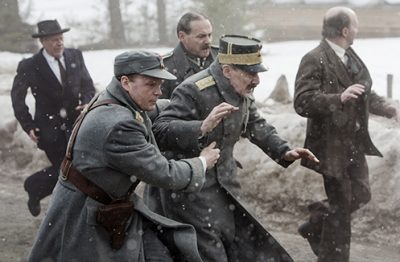Norwegians streamed to local cinemas over the weekend to see the new film Kongens nei, about the three dramatic days in April 1940 when the late King Haakon VII flatly refused to cooperate with Nazi German invaders. The film has made many Norwegians proud of the royal defiance, which ultimately turned the royals themselves into refugees in exile abroad.

The powerful film, based on a book by Alf R Jacobsen, packed many cinemas around the country after it formally premiered on Friday. Nordisk Film Distribution reported that nearly 118,000 people bought tickets to see Kongens nei (literally, The king’s no) during its opening weekend. That comes in addition to the roughly 10,000 people who braved pouring rain last week to watch the film in a special outdoor showing on the grounds of the Royal Palace in Oslo, with members of the royal family in attendance.
Thousands more saw the film in other special pre-release showings, bringing the total by Monday to nearly 140,000. That puts it close to the premiere crowds at earlier major Norwegian films including Max Manus (named after the Norwegian resistance hero during the war), Bølgen (The Wave) and even Kon-Tiki. “This is fantastic,” said the film’s producer, Stein B Kvae. “We’re extremely glad that the Norwegian public seems to be flocking to see Kongens Nei.”
Ongoing fascination with the war
Interest is clearly fueled by Norwegians’ seemingly endless fascination with World War II and its dramatic, lasting effects. The film, directed by Erik Poppe, has won almost universally good reviews and become one of Norway’s candidates for a foreign film Oscar. After sitting through the more than two-hour account of April 8-11, 1940, it’s easy to understand why. It’s a gripping film praised for its historic accuracy and honesty, which also portrays no lack of personal drama between Norway’s first modern monarch and his son, the father of the current Norwegian king.
The film is also highly relevant, coming at a time when Norway has found itself hosting thousands of refugees from the war in Syria and other deeply troubled nations. It wasn’t too long ago that Norway also produced war refugees and hundreds of thousands of emigrants seeking better lives abroad.

The film also offers a surprisingly sympathetic version of the role played by the German ambassador to Norway at the time, Curt Bräuer, who came as close as he could to defying his invading countrymen and Hitler himself as he insisted on trying to use diplomacy to negotiate directly with King Haakon VII. The film goes on to show Bräuer losing the support of his wife and being literally shut out of invading military officers’ decisions, while text at the end of the film notes that Bräuer himself was later sent to the eastern front.
It was to Bräuer that King Haakon, a former Danish prince who was clearly proud of being the only monarch in Europe to have been elected at the time, delivered his refusal to bow to the Germans and turn over leadership of the country to Hitler’s forces and their puppet government led by coup maker Vidkun Quisling. Several Norwegians attending the royal showing last week carried flags in backpacks “to celebrate our freedom,” one of them, Arnt Telhaug, told newspaper Aftenposten. On Tuesday, 20-year-old Kari-Anne Helland Barland wrote in Aftenposten that she was “proud to be Norwegian” after seeing the film, stressing that late king’s “no” was a resounding “yes” to democracy and rule by the people.
Commentators have tempered such patriotism outbursts a bit in recent days. Lars West Johnsen of newspaper Dagsavisen, noted, for example, that the king’s defiance was followed “uncomfortably quickly” by Norwegian pragmatism that took over after the royal family and elected government fled the country. “Life had to go on,” Johnsen wrote, and many Norwegians did end up cooperating with their occupiers. He also noted, however, how the film was “made with care and respect for the factual events,” which will allow it to stand as a “document over a central part of our history.”
More historic war films likely
There’s also reason to hope that the film, and its popularity, will boost interest in other sides of Norwegian war history including how retreating Nazi German occupiers used “scorched earth” tactics to burn most all the buildings and homes in the northern county of Finnmark while withdrawing. That created another wave of around 50,000 Norwegian war refugees, many of whom weren’t welcome even in other areas of their own country.
Other film topics in the years to come may include the Battle for Narvik, which Tommy Wirkola has expressed interest in directing, along with war stories from Western Norway, not just Oslo. Some critics have claimed that war films made so far tend to concentrate on Oslo, with the exception, of course, of Telemark. Kongens nei, for example, is being hailed in Hedmark County where most of the drama and initial fighting actually played out.
“The question is raised every year,” wrote Johnsen, by journalists, historians and commentators: “Will we never be finished with the war? Is there really more to tell? Clearly yes.” Eyewitnesses and others who experienced the war are dying out, but new archive material continues to pop up. New generations are curious about the seemingly unreal events that took place in the early 1940s, with photos of Oslo used in the film still so eerily similar to the Oslo of today. More films will come, and at least one of those seeing Kongens nei already wants to see it again.
newsinenglish.no/Nina Berglund

